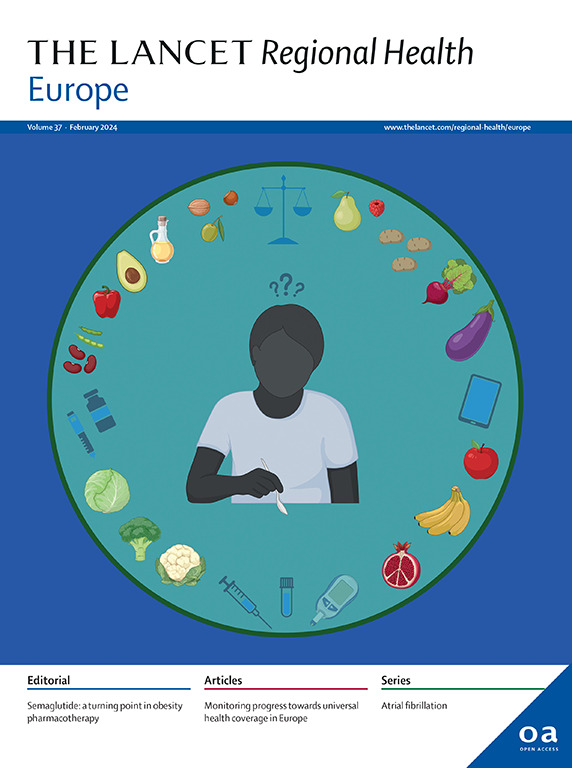Association between socioeconomic factors and semaglutide use for weight loss: a population-based cross-sectional study in Denmark
IF 13
Q1 HEALTH CARE SCIENCES & SERVICES
引用次数: 0
Abstract
Background
Glucagon-like peptide-1 agonists like semaglutide are effective treatments for obesity. High costs may create economic barriers. This study examines the association between income and prescriptions for semaglutide for weight loss.
Methods
This nationwide register-based cross-sectional study of all adults in Denmark without diabetes, analyzed the association between household income adjusted for family size divided into quartiles and semaglutide prescription redemption for weight loss. We obtained weight and height on a representative sample of the population from The Copenhagen General Population Study which randomly selected individuals in 2014–2019. Obesity was defined as a body mass index >30 kg/m2.
Findings
A total of 4,531,146 adult individuals were included after excluding individuals with diabetes (186,823, 3·8%), and individuals without income data (146,639, 3·0%). The proportion of individuals with a redeemed semaglutide prescription increased with income, from 1·3% (n = 13,925) in the lowest income quartile to 3·6% (n = 41,298) in the highest. Conversely, in a representative sample of 36,391 individuals, the proportion living with obesity was 26% (n = 1310) in the lowest income quartile compared to 13% (n = 1872) in the highest. During the year 2023 we found a general increase in Semaglutide use from 40,605 (0·9%) in the first quarter of 2023 to 85,250 (1·9%) in the fourth quarter, which was most pronounced in women in the highest income group with an increase from 10,818 (1·9%) to 23,069 (4·1%).
Interpretation
Semaglutide use increased with income while obesity declined. This suggests that economic concerns lead to a systematic undertreatment for obesity for low-income individuals, potentially exacerbating existing health inequalities.
Funding
None.
社会经济因素与西马鲁肽用于减肥之间的关系:丹麦一项基于人群的横断面研究
胰高血糖素样肽-1激动剂如西马鲁肽是治疗肥胖的有效药物。高成本可能造成经济障碍。本研究探讨了收入与服用西马鲁肽减肥之间的关系。方法:这项以全国登记为基础的横断面研究纳入了丹麦所有无糖尿病的成年人,分析了家庭收入(按四分位数划分)与西马鲁肽减肥处方赎回之间的关系。我们从2014-2019年随机选择的哥本哈根普通人口研究中获得了具有代表性的人口样本的体重和身高。肥胖被定义为体重指数为30 kg/m2。结果:在排除糖尿病患者(186,823,3.8%)和无收入数据的个体(146,639,3.0%)后,共纳入4,531,146名成年人。赎回西马鲁肽处方的个人比例随着收入的增加而增加,从最低收入四分位数的1.3% (n = 13,925)到最高收入四分位数的3.6% (n = 41,298)。相反,在36391人的代表性样本中,最低收入四分位数中肥胖的比例为26% (n = 1310),而最高收入四分位数中肥胖的比例为13% (n = 1872)。在2023年期间,我们发现Semaglutide的使用从2023年第一季度的40,605(0.9%)增加到第四季度的85,250(1.9%),这在最高收入群体的女性中最为明显,从10,818(1.9%)增加到23,069(1.1%)。semaglutide的使用随着收入的增加而增加,而肥胖则下降。这表明,对经济的担忧导致了低收入人群对肥胖的系统性治疗不足,潜在地加剧了现有的健康不平等。
本文章由计算机程序翻译,如有差异,请以英文原文为准。
求助全文
约1分钟内获得全文
求助全文
来源期刊

Lancet Regional Health-Europe
Multiple-
CiteScore
19.90
自引率
1.40%
发文量
260
审稿时长
9 weeks
期刊介绍:
The Lancet Regional Health – Europe, a gold open access journal, is part of The Lancet's global effort to promote healthcare quality and accessibility worldwide. It focuses on advancing clinical practice and health policy in the European region to enhance health outcomes. The journal publishes high-quality original research advocating changes in clinical practice and health policy. It also includes reviews, commentaries, and opinion pieces on regional health topics, such as infection and disease prevention, healthy aging, and reducing health disparities.
 求助内容:
求助内容: 应助结果提醒方式:
应助结果提醒方式:


